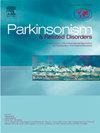The interplay between obesity and triglyceride-glucose index in modulating Parkinson's disease risk: A cross-sectional NHANES study of middle-aged and young adults
IF 3.4
3区 医学
Q2 CLINICAL NEUROLOGY
引用次数: 0
Abstract
Introduction
The triglyceride-glucose (TyG) index is a newly proposed biomarker of insulin resistance, and its relationship with Parkinson's disease (PD) remains to be studied, particularly among individuals with obesity. This study examined the relationship between insulin resistance and PD risk, assessing whether obesity modulates this association.
Methods
Data from the National Health and Nutrition Examination Survey (2003–2018) were analyzed, focusing on 6349 participants aged 20–65 years. Participants were stratified by body mass index (BMI), and multivariate logistic regression was used to evaluate the relationship between TyG index and PD risk in individuals with and without obesity. Odds ratio (OR) with 95 % confidence intervals (CIs) were calculated using a logistic regression analysis model.
Results
A positive correlation between the TyG index and PD risk was observed in this cross-sectional analysis, specifically among individuals with obesity (OR = 2.21, 95 % CI: 1.32–3.7) but not in those without obesity (OR = 1.16, 95 % CI: 0.67–2.02). A statistically significant multiplicative interaction between obesity and the TyG index was identified(P = 0.005).
Conclusion
The TyG index is significantly associated with PD risk, with obesity potentially playing a key role. This exploratory study suggests the TyG index may serve as a possible low-cost marker for identifying individuals with obesity at higher likelihood of having PD, though replication in population-based prospective studies is required before clinical application.
肥胖和甘油三酯-葡萄糖指数在调节帕金森病风险中的相互作用:一项针对中青年成人的横断面NHANES研究
甘油三酯-葡萄糖(TyG)指数是一种新提出的胰岛素抵抗生物标志物,其与帕金森病(PD)的关系仍有待研究,特别是在肥胖个体中。本研究检查了胰岛素抵抗和帕金森病风险之间的关系,评估肥胖是否调节了这种关联。方法:对2003-2018年全国健康与营养检查调查数据进行分析,重点分析6349名年龄在20-65岁之间的参与者。根据体重指数(BMI)对参与者进行分层,并使用多变量logistic回归来评估有肥胖和无肥胖个体的TyG指数与PD风险之间的关系。采用logistic回归分析模型计算95%置信区间的比值比(OR)。结果:在横断面分析中观察到TyG指数与PD风险呈正相关,特别是在肥胖个体中(OR = 2.21, 95% CI: 1.32-3.7),而在非肥胖个体中没有(OR = 1.16, 95% CI: 0.67-2.02)。肥胖与TyG指数之间存在统计学上显著的乘法交互作用(P = 0.005)。结论:TyG指数与PD风险显著相关,肥胖可能起关键作用。这项探索性研究表明,TyG指数可能作为一种低成本的标记物,用于识别患有PD的可能性较高的肥胖个体,尽管在临床应用之前需要在基于人群的前瞻性研究中进行复制。
本文章由计算机程序翻译,如有差异,请以英文原文为准。
求助全文
约1分钟内获得全文
求助全文
来源期刊

Parkinsonism & related disorders
医学-临床神经学
CiteScore
6.20
自引率
4.90%
发文量
292
审稿时长
39 days
期刊介绍:
Parkinsonism & Related Disorders publishes the results of basic and clinical research contributing to the understanding, diagnosis and treatment of all neurodegenerative syndromes in which Parkinsonism, Essential Tremor or related movement disorders may be a feature. Regular features will include: Review Articles, Point of View articles, Full-length Articles, Short Communications, Case Reports and Letter to the Editor.
 求助内容:
求助内容: 应助结果提醒方式:
应助结果提醒方式:


